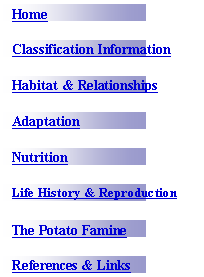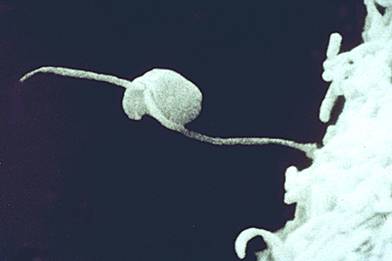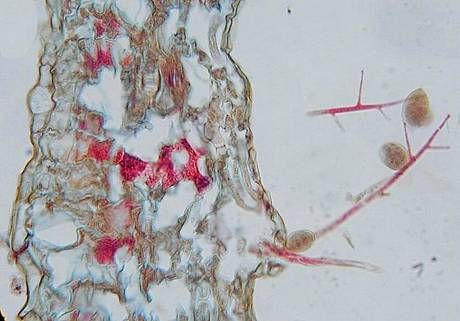

|
Classification Information |
|
Domain: Eukarya Kingdom: Stramenopila Phylum: Oomycota Class: Oomycetes* Order: Peronosporales Family: Pythiaceae Genus: Phytophthora Species: Phytophthora infestans |

|
Phytophthora infestans has been moved around a lot. Before it was classified as being a fungus, when it actually does not fit the “mold” (Volk 2001). Generally, P. infestans is accepted as being classified as the above chart dictates. |
|
This organism is defined as eukaryotic because its cells contain nuclei and membrane-bound organelles. It belongs in the kingdom Stramenopila because it has a whiplash flagellum and tinsel flagellum on its zoospores. (Both of these flagella have hollow hair-like structures which is another characteristic of the Stramenopila.) The whiplash flagellum is on the posterior end of the zoospore and allows for movement in water by pushing it forward, while the tinsel flagellum is on the anterior end, points forward and pulls the spore through the water (Volk 2001).
|
|
Sometimes It’s Hard to Fit in |



|
The next level down is the phylum. P. infestans is an oomycete * (belonging to the Oomycota, which are generally not divided into classes) because they have cell walls composed of cellulose and store their food as starch. As a side note, these are the major two reasons why they are not considered fungi (Volk 2001). On the phylogenic tree on the upper-right, we can see how close in relation to other organisms Oomycota are. (This tree is based on small-subunit rRNA sequence similarities and was adapted from Forester et al. 1990 and Illingworth et. al. 1991 by Judelson in his 1997 article on |
|
the genetics and biology of P. infestans, and recreated by me.) The oomycetes, as shown in this tree, are more closely related to chrysophytes, diatoms, and brown algae based on their metabolism, cell wall composition, and rRNA sequence than they are to ascomycota or basidiomycota. Sometimes the oomycetes are erroneously classified as being more closely related to these two major groups of fungi because of their filamentous growth, but as the data shows, they indeed are not (Judelson 1997). P. infestans is classified as being in the order Peronosporales because it is a plant pathogen. This order contains three plant pathogen families: the Peronosporaceae, Pythiaceae, and Albuginaceae. The family Pythiaceae contains obligate and nonobligate parasites which could fall genera such as Phytophthora or Pythium. Species within the Pythium cause rotting of the roots, seeds, or seedlings. Species within the Phytophthora genera, however, cause various blights on tomatoes, potatoes, peppers, curcubits, and can also cause rotting of the stems or roots (Heffer, Powelson, and Johnson 2002). The species name, Phytophthora infestans, literally means the “infesting plant destroyer,” which indeed it is (Volk 2001). |
|
Biflagellate zoospore (scanning electron micrograph) (1). |
|
Photo Credits 1. Courtesy M. Brown. Reproduced with permission from Schumann, G. L. and C. J. D’Arcy. 2000. Late blight of potato and tomato. The Plant Health Instructor. DOI: 10.1094/PHI-I-2000-0724-01. 2. Courtesy T.J. Volk. Reproduced with permission from T.J. Volk. 2001. Phytophthora infestans, cause of late blight of potato and the Irish potato famine. |
|
Phytophthora sporangium (2). |